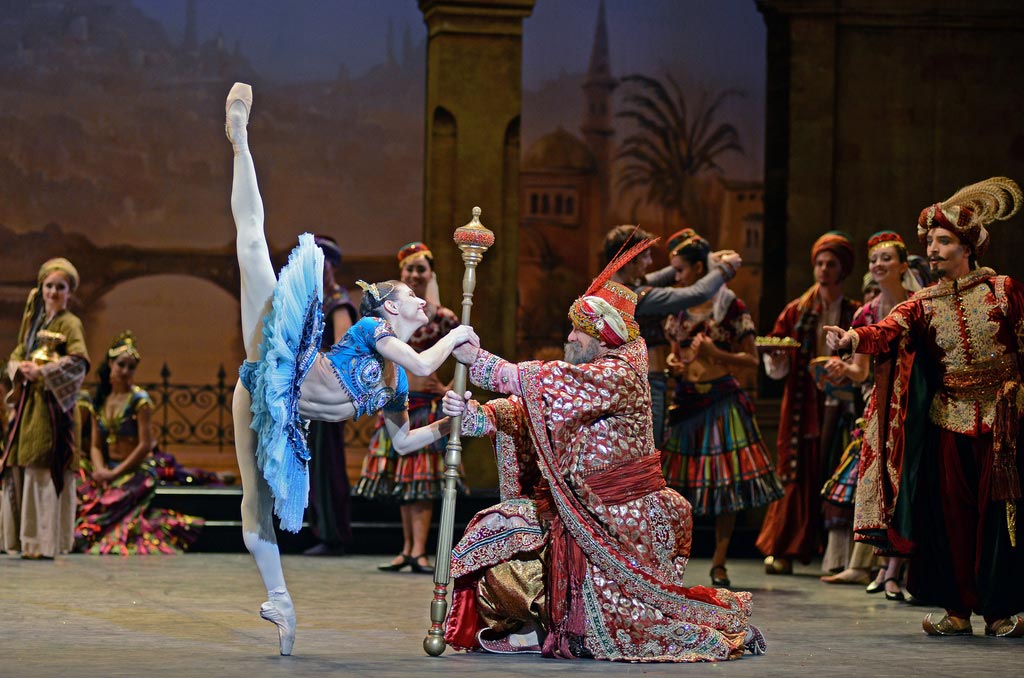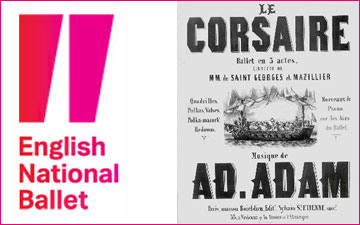
© Dave Morgan. (Click image for larger version)
English National Ballet
Le Corsaire
London, Coliseum
8 January 2014
Gallery of pictures by Dave Morgan
Gallery of pictures by Foteini Christofilopoulou
ballet.org.uk
Anna-Marie Holmes’s latest staging of Le Corsaire has proved to be a triumph for English National Ballet – if only audiences on tour can be converted to booking en masse for an unfamiliar ballet spectacular. No other British company dances a full-length account of the 19th century ballet, although the Act II pas de deux for ballerina and exotically dressed partner has been a gala staple since Margot Fonteyn and Rudolf Nureyev first performed it in 1962. (In context, it’s actually a pas de trois.)
In 1988, when the (then) Kirov Ballet presented the extracted Jardin animé scene from its Le Corsaire production at the Islington Design Centre, few London ballet-goers had any idea what the ballet was all about, or indeed what part animated flowers might play in the plot. When the Kirov/Mariinsky brought the full-length production to London a year later, lucky audiences could appreciate the cornucopia of ‘après Petipa’ choreography that poured forth over three hours and more. These days, DVDs of various Corsaires, Russian and American, are readily available.

© Dave Morgan. (Click image for larger version)
Thanks to Anna-Marie Holmes, the Boston Ballet and then American Ballet Theatre acquired her production in 1987/8, based on Konstantin Sergeyev’s 1974 staging for the Kirov. By the time Tamara Rojo requested it for ENB, Holmes’s account has become highly polished, trimmed to two and a half hours (including intervals). New designs commissioned from Bob Ringwood’s are gorgeously lavish; the rumbustious score, attributed to some nine composers, is played with verve by ENB’s orchestra, conducted by Gavin Sutherland; the standard of dancing is admirable. What’s not to enjoy?
True, the plot is preposterous (though nowhere near as tangled as the 1853 synopsis by Mazilier in Cyril Beaumont’s Complete Book of Ballets). It’s easy enough to follow in action, in spite of some dramatic leaps of logic and morality. Women keep getting abducted: some mind, some don’t – Gulnare, the second ballerina role, comes to relish her status as queen of the Pasha’s harem. I’ve no idea why three odalisques should audition so delectably as his prospective, then rejected, multiple brides. (Their solos are usually reserved for the Jardin animé scene.) However, in this production the Pasha – Michael Coleman at his twinkliest – is a jolly old soul, easily bamboozled by pretty girls and opium pipes. Life in his luxurious harem is evidently preferable to being kidnapped by pirates, however glamorous their cave hide-out may be in Act II. But the cowering captives are soon freed, so that’s alright.

© Dave Morgan. (Click image for larger version)
Men in this production have plenty of opportunities to show off, as pirates, slave-traders and virile folk-dancers. Leading roles were taken with brio on the Coliseum opening night by Vadim Muntagirov as the hero, Conrad; Junor Souza as his slave, Ali; Yonah Acosta as the pirate chief, Birbanto; Dmitri Gruzdyev as the unscrupulous Lankendem; and, in a supporting role, Juan Rodriquez as the Pasha’s comic assistant. Though Souza and Acosta unleashed plenty of firework feats in their solos, Muntagirov outdid them in elegance and elevation to deserve his prize – Alina Cojocaru as the heroine, Medora. Muntagirov now has the assurance of knowing that he is indeed an exceptional dancer, without the arrogance that can sometimes impair such awareness.

© Dave Morgan. (Click image for larger version)
He brought off the finest of many rivoltades, the virtuoso step in which a male dancer appears to jump over his raised leg, landing in the opposite direction in arabesque – and what an arabesque. Cojocaru, petite though she is, matched his long line in their pas de deux, where she seemed to fly in his arms. My only quibble is the abruptness of her over-extended arabesques penchées, which mar her musicality as well as appearing acrobatic: too much gusset, too ugly an upflung pointe shoe. Otherwise, it’s a rare pleasure to see the exquisite angles of her head, neck and shoulders and the way she is impelled by the music, instead of anticipating it (as several of the female soloists tended to do, trying to fit in their fiendishly fast steps). Cojocaru makes Medora a feisty, playful heroine, capable of great tenderness in her passionate pas de deux with Conrad, as well as bravura grace in the pas de trois with Ali.

© Dave Morgan. (Click image for larger version)
Shiori Kase as Gulnare complemented Cojocaru in poise in the Jardin animé sequence – the Pasha’s intoxicated dream of garlands of women and children as floral beauties. Though Ringwood’s fantastical scrim is magical, the set-piece, simplified for touring, is uninspired without the odalisques and plentiful baskets of flowers. Act III is disappointing as a finale, scrambling through the plot with a swift massacre, execution, rescue and shipwreck. Gulnare and Ali tumble overboard, presumed drowned, while Medora and Conrad cling to a rock in an unsatisfactory apotheosis. Byron’s 1814 poem, The Corsair, on which the ballet is very loosely based, ends inconclusively, but a theatrical production needs to send its audience home on a high. The smiles that greeted the first two acts had faded in the third, until replaced by cheers for the performers as they took their bows.

















You must be logged in to post a comment.